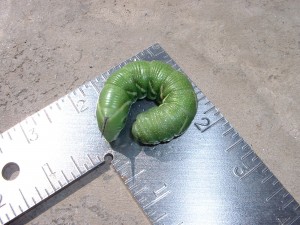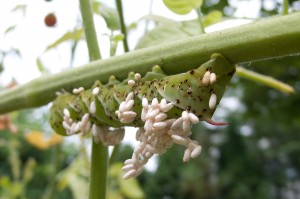The other day in the garden, I stood admiring the new Caribbean hot peppers that 20 Minute Jim had planted earlier this year. As a hot pepper aficionado, he had been very excited to a new pepper to the varieties growing in the garden. I observed the green peppers hanging under the leaves, and then an odd shaped pepper poking up among the foliage caught my eye. That’s weird, thought I. And I reached out and touched this weird pepper… and it moved!
AAAA-gggghhhhh!
My shriek certainly startled the neighborhood or at least the chickens next door.
I was too hot and shook up to trudge all the way upstairs to find my favorite gardening pest book (The Organic Gardener’s Handbook of Natural Insect and Disease Control: A Complete Problem-Solving Guide to Keeping Your Garden and Yard Healthy Without Chemicals), so I instead consulted the internet. Googling “big green worm” immediately brought some of the desired information. The big green worm was a tomato hornworm, the larval stage of the Manduca quinquemaculata. As I suspected, it was a foe, rather than a friend, to the garden and one possessing a voracious appetite.
The advice I read was to pick off and kill tomato worms, with one exception that I’ll detail in the next paragraph. Large wormy pests are not things I can pick off using my fingers. I returned to the garden with a plastic container and its lid, thinking I could knock said tomato worm into the container. But no. Tomato worms have several sets of rather powerful legs. They cling. I donned my handy gardening gloves and returned to plucking. The worm was not cooperative; I had to tug firmly as each set of legs reluctantly let go of the pepper plant stem. I put him in the container for disposal, after showing him off to anyone who’d listen to my tale of woe. And I shivered for a few minutes. Ugh.
When shouldn’t a gardener pluck up the offending tomato hornworm and mush it out of existence? When the worm looks like this:
A tomato hornworm who looks like rice is stuck on its back has already met its end: it has been parasitized by the Braconidae wasp larvae, a beneficial insect, a gardener’s friend. This tomato hornworm has become a nursery for Braconidea wasps, which will attack tomato hornworms and other harmful insects in your garden. A parasitized tomato hornworm should be left as is.
Tomato hornworms like to eat various plants from the family Solanaceae, including tomato, eggplant, pepper, and potato; they also attack tobacco but we don’t grow that. I’m keeping a daily patrol on the rest, however, watching for areas of defoliation. So far, I haven’t found another big green worm, but I know the old gardening adage of “one insect seen usually means more than one in the garden” so I’m remaining vigilant.




